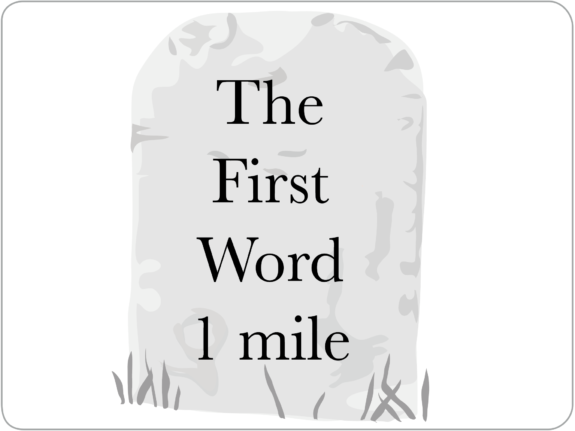
Mile stones
Three well-accepted examples
In the development of speech and language
There are three well-accepted mile stones in the development of speech and language, the first words, the first combinations of two words, and the point when a child can be understood most of the time by adults who don’t know him or her. Mile stones help parents and professionals decide whether intervention is necessary and when. Rather surprisingly the necessary steps are taken in an almost invariable order. But each individual child has his or her own ideas about the schedule.
The clear mile stones seem to be more or less as follows:
- When the child says his or her first words (normally around one). This may be the first name of a parent, Mummy or Daddy, a familiar item of food or clothing, something interesting ike a bus, a tractor, or an animal, or a greeting, hello or goodbye or bye bye, and more. It may be a long way off-target in terms of sound structure, but you know, or you think you know, what it’s supposed to be;
- When he or she first combines two words or parts of words in one utterance. There are different ways of defining what counts as a ‘word’ – both generally and in the context here. By the proposal here, there are two significant steps in the process of putting words together, with “Bye, Daddy” by one step, and “See Daddy” by a later step;
- When he or she can be understood most of the time by adults who don’t know him or her (normally around three and a half). Sometimes this is said to be ‘talking perfectly’. But it is exceedingly rare for children to reach adult levels of speech and language as early as this. Most children go on learning to talk until they are around ten.
Very rarely, a child of five can take part in discussion about matters of adult interest.
See https://speechandlanguage.org.uk/talking-point/parents/ages-and-stages/ for an Ages and Stages listing of roughly what might be expected when from six months to seventeen years, from a perspective rather different from the framework and the biolinguistics assumed here.
There may seem to be an obvious discrepancy between the ages, as given in the Proposal here, based on the close observation of two normally developing children over ten years, and listing by Ages and Stages. The former may seem vastly more precocious. For instance, the former exemplifies structures such as “I want to stand on the chair to see what’s happening” with three levels of embedding two months before the third birthday in contrast to the one clause sentences exemplified by Ages and Stages as typical of four year old talk. But there is no discrepancy here. The child who said “I want to stand on the chair to see what’s happening” at nearly three asked his first simple question “Who’s that?” just before two, and then “I don’t know what you want, Teddy” eight months later, and then six weeks after that the more complex structure with three levels of embedding rather than just one. The other child studied here took five months to increase the embedding by just one degree. This is typical of the up and down scheduling by individual children. But the criteria here are enormously selective. By the results of Klaus Wagner (1985), he is likely to have spoken almost a million words over this ten month period. Quite deliberately, the criteria here are enormously selective. The sentences are not in any way reprentative of what the child was mostly saying at any of the three points exampled here. But they are useful because they reveal the maturation of a very subtle and intricate system, known as ‘Universal Grammar’. At first it is very difficult for children to use. They only succeed in demonstrating the full scale of this maturation very occasionally, in maybe one utterance out of 100,000. It takes another seven years or so to learn to use the system reliably and accurately more or less all the time.
For better or worse, the framework here focuses on syntax, as opposed to discourse, as seemingly assumed by the Ages and Stages framework. The latter is covers a broad spectrum of the useful, natural, fun activities. This contrasts in a rather extreme way with the very narrowly syntactic view spelt out in some detail by the proposal here. I personally think that a narrow syntactic view is clinically useful, as implictly suggested by Catherine Renfrew’s 1967 Action Picture Test. Only careful observation by parents can supply the sort of data listed in the proposal here. But this requires a significant commitment over time by whoever has the role of principal care-giver. For general purposes, the three mile stones above seem to me invaluable.
Only the most approximate of schedules
First, during the second half of the first year, the child babbles, rehearsing the forms of speech and language with no detectable meanings or intentions. Then the child starts producing what Martin Braine (1962) called ‘holophrases’ – expressions which sound like they might contain more than one word – but not occurring on their own – like OZAH, as an expression of apparent curiosity, possibly modeled on “What’s that?”. Then gradually the elements become more distinct, as in “Mummy bye” or “Daddy bye”, with no clear structural relation between the elements, Then, typically sometime between 18 and 21 months, elements more recognisable as words start to be put together. The child says something like “MM BAH” as he or she is being put into the bath, with two contrasting elements relating to a significant entity in the child’s universe, in this case bath, and a plausible version of the preposition in, in a primitive prototype of a phrase. Then between a week and three months after saying something like “In bath” most naturally interpreted as a simple ‘declarative’, as such structures are known, the child either asks a question like “Where Daddy?” or answers a fully formed corresponding question by an adult like “Where’s Daddy?” by an appropriate and plausible reference to place, possibly by a single word. But not in the opposite order. In other words, two word declaratives precede one word answers to questions, even though the one word answer might seem simpler. This is the lowermost point which can be characterised in terms of the sort of relation, outlined by the Framework here. From this point, acquisition can be plotted by a seven-step path towards the essentials of the end-state. But there is no schedule, other than a very approximate one. Each child has his or her own ideas about this.
But as Roger Brown (1973) remarks a number of times in a seminal early study, the ordering of the various grammatical points in relation to one another is signally consistent across the various children studied.

